Developing Personal Skills for Health Promotion in Older Adults
VerifiedAdded on 2020/04/29
|10
|4555
|162
AI Summary
The assignment delves into the significance of personal skill development within the framework of health promotion for older adults, referencing the Ottawa Charter's principles. By analyzing public stigma towards depression in elderly populations and the barriers they face in accessing healthcare, it identifies strategies to improve mental health and mobility through community-based supports. The role of policy fragmentation in mental health care provision is also discussed, highlighting the need for cohesive approaches that integrate personal skill development as a core component. This comprehensive analysis underscores the imperative for targeted health promotion initiatives that empower older adults to maintain their well-being and autonomy.
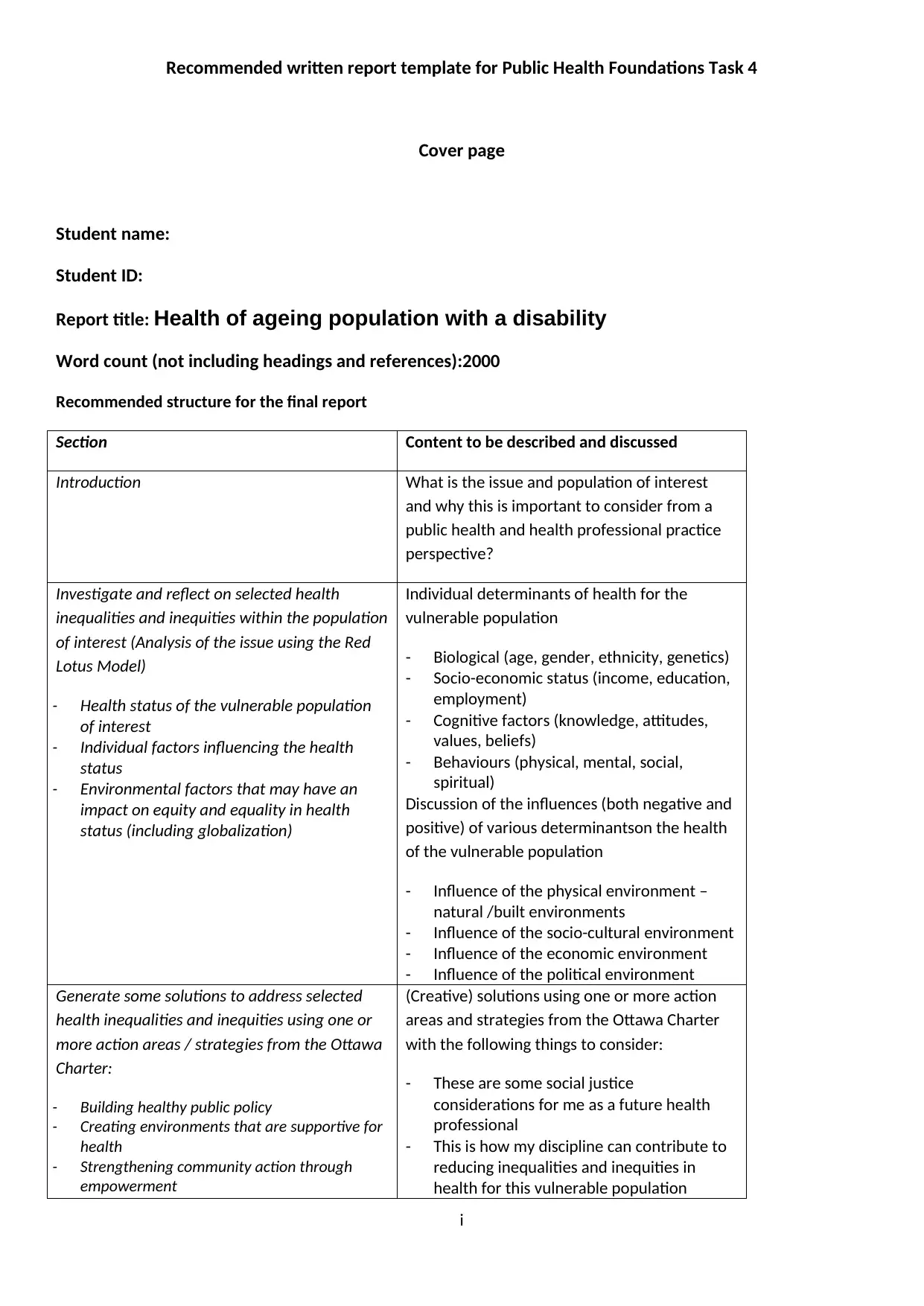
Recommended written report template for Public Health Foundations Task 4
Cover page
Student name:
Student ID:
Report title: Health of ageing population with a disability
Word count (not including headings and references):2000
Recommended structure for the final report
Section Content to be described and discussed
Introduction What is the issue and population of interest
and why this is important to consider from a
public health and health professional practice
perspective?
Investigate and reflect on selected health
inequalities and inequities within the population
of interest (Analysis of the issue using the Red
Lotus Model)
- Health status of the vulnerable population
of interest
- Individual factors influencing the health
status
- Environmental factors that may have an
impact on equity and equality in health
status (including globalization)
Individual determinants of health for the
vulnerable population
- Biological (age, gender, ethnicity, genetics)
- Socio-economic status (income, education,
employment)
- Cognitive factors (knowledge, attitudes,
values, beliefs)
- Behaviours (physical, mental, social,
spiritual)
Discussion of the influences (both negative and
positive) of various determinantson the health
of the vulnerable population
- Influence of the physical environment –
natural /built environments
- Influence of the socio-cultural environment
- Influence of the economic environment
- Influence of the political environment
Generate some solutions to address selected
health inequalities and inequities using one or
more action areas / strategies from the Ottawa
Charter:
- Building healthy public policy
- Creating environments that are supportive for
health
- Strengthening community action through
empowerment
(Creative) solutions using one or more action
areas and strategies from the Ottawa Charter
with the following things to consider:
- These are some social justice
considerations for me as a future health
professional
- This is how my discipline can contribute to
reducing inequalities and inequities in
health for this vulnerable population
i
Cover page
Student name:
Student ID:
Report title: Health of ageing population with a disability
Word count (not including headings and references):2000
Recommended structure for the final report
Section Content to be described and discussed
Introduction What is the issue and population of interest
and why this is important to consider from a
public health and health professional practice
perspective?
Investigate and reflect on selected health
inequalities and inequities within the population
of interest (Analysis of the issue using the Red
Lotus Model)
- Health status of the vulnerable population
of interest
- Individual factors influencing the health
status
- Environmental factors that may have an
impact on equity and equality in health
status (including globalization)
Individual determinants of health for the
vulnerable population
- Biological (age, gender, ethnicity, genetics)
- Socio-economic status (income, education,
employment)
- Cognitive factors (knowledge, attitudes,
values, beliefs)
- Behaviours (physical, mental, social,
spiritual)
Discussion of the influences (both negative and
positive) of various determinantson the health
of the vulnerable population
- Influence of the physical environment –
natural /built environments
- Influence of the socio-cultural environment
- Influence of the economic environment
- Influence of the political environment
Generate some solutions to address selected
health inequalities and inequities using one or
more action areas / strategies from the Ottawa
Charter:
- Building healthy public policy
- Creating environments that are supportive for
health
- Strengthening community action through
empowerment
(Creative) solutions using one or more action
areas and strategies from the Ottawa Charter
with the following things to consider:
- These are some social justice
considerations for me as a future health
professional
- This is how my discipline can contribute to
reducing inequalities and inequities in
health for this vulnerable population
i
Paraphrase This Document
Need a fresh take? Get an instant paraphrase of this document with our AI Paraphraser
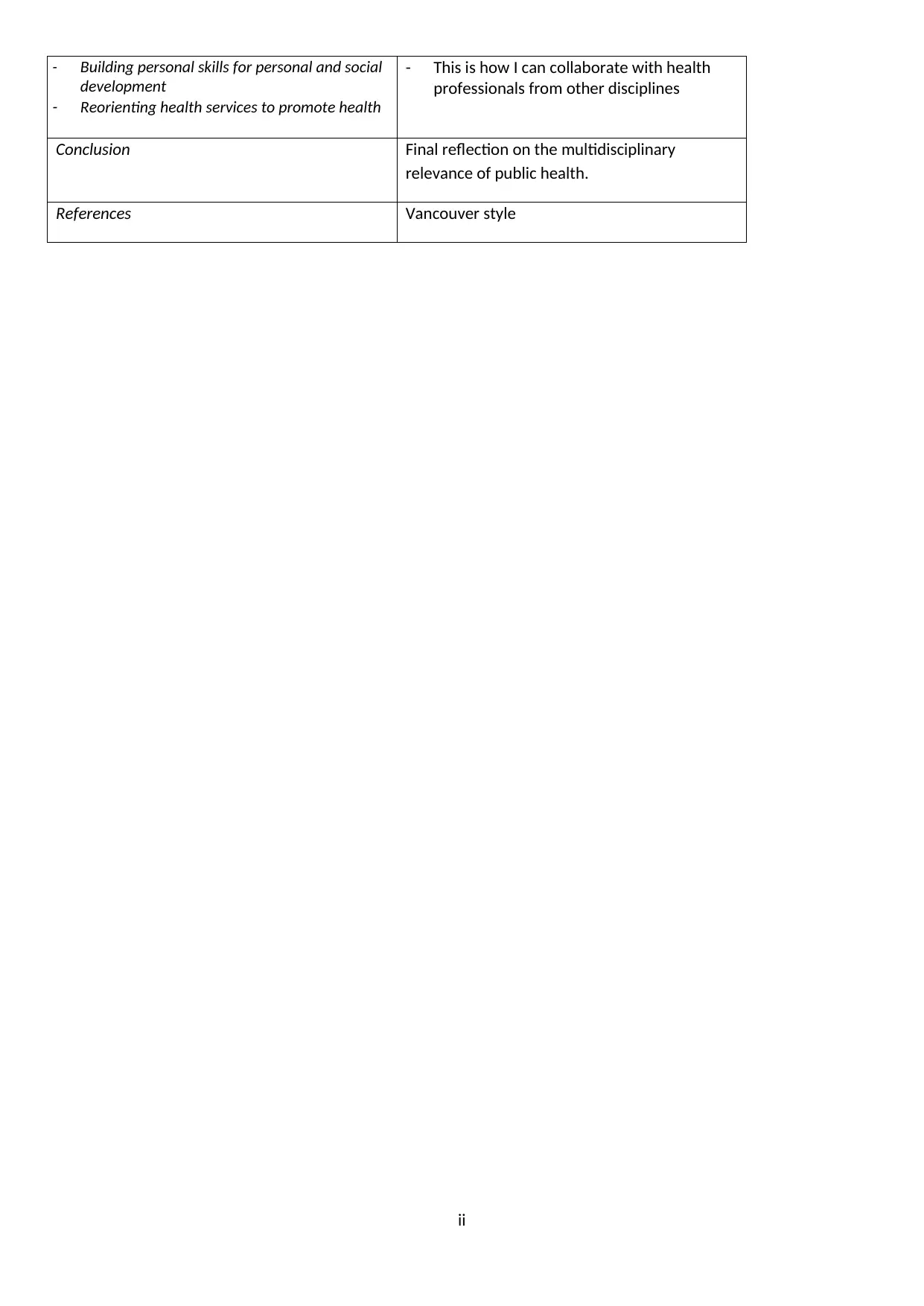
- Building personal skills for personal and social
development
- Reorienting health services to promote health
- This is how I can collaborate with health
professionals from other disciplines
Conclusion Final reflection on the multidisciplinary
relevance of public health.
References Vancouver style
ii
development
- Reorienting health services to promote health
- This is how I can collaborate with health
professionals from other disciplines
Conclusion Final reflection on the multidisciplinary
relevance of public health.
References Vancouver style
ii
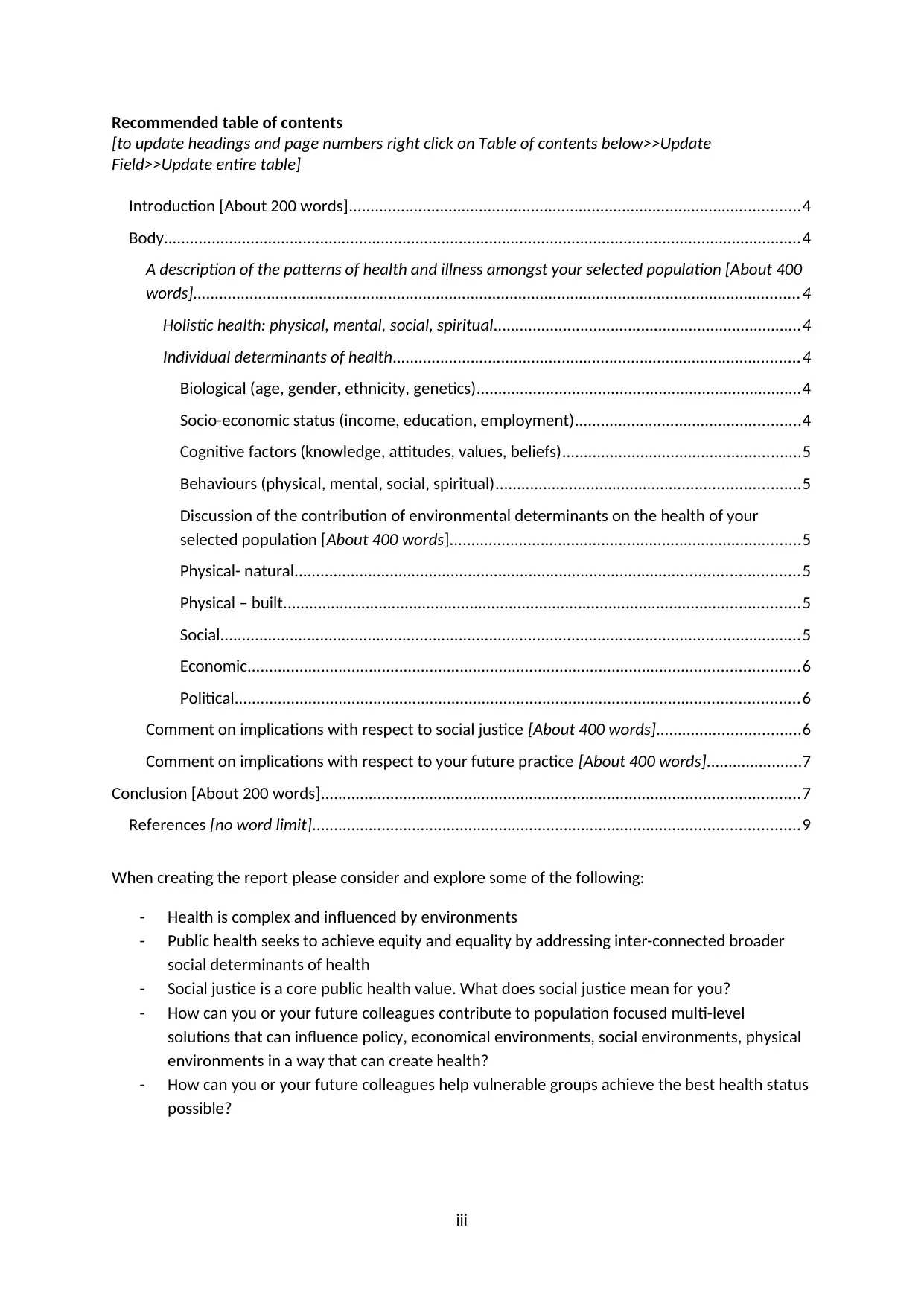
Recommended table of contents
[to update headings and page numbers right click on Table of contents below>>Update
Field>>Update entire table]
Introduction [About 200 words]........................................................................................................4
Body...................................................................................................................................................4
A description of the patterns of health and illness amongst your selected population [About 400
words]............................................................................................................................................4
Holistic health: physical, mental, social, spiritual.......................................................................4
Individual determinants of health..............................................................................................4
Biological (age, gender, ethnicity, genetics)...........................................................................4
Socio-economic status (income, education, employment)....................................................4
Cognitive factors (knowledge, attitudes, values, beliefs).......................................................5
Behaviours (physical, mental, social, spiritual)......................................................................5
Discussion of the contribution of environmental determinants on the health of your
selected population [About 400 words].................................................................................5
Physical- natural....................................................................................................................5
Physical – built.......................................................................................................................5
Social......................................................................................................................................5
Economic...............................................................................................................................6
Political..................................................................................................................................6
Comment on implications with respect to social justice [About 400 words].................................6
Comment on implications with respect to your future practice [About 400 words]......................7
Conclusion [About 200 words]..............................................................................................................7
References [no word limit]................................................................................................................9
When creating the report please consider and explore some of the following:
- Health is complex and influenced by environments
- Public health seeks to achieve equity and equality by addressing inter-connected broader
social determinants of health
- Social justice is a core public health value. What does social justice mean for you?
- How can you or your future colleagues contribute to population focused multi-level
solutions that can influence policy, economical environments, social environments, physical
environments in a way that can create health?
- How can you or your future colleagues help vulnerable groups achieve the best health status
possible?
iii
[to update headings and page numbers right click on Table of contents below>>Update
Field>>Update entire table]
Introduction [About 200 words]........................................................................................................4
Body...................................................................................................................................................4
A description of the patterns of health and illness amongst your selected population [About 400
words]............................................................................................................................................4
Holistic health: physical, mental, social, spiritual.......................................................................4
Individual determinants of health..............................................................................................4
Biological (age, gender, ethnicity, genetics)...........................................................................4
Socio-economic status (income, education, employment)....................................................4
Cognitive factors (knowledge, attitudes, values, beliefs).......................................................5
Behaviours (physical, mental, social, spiritual)......................................................................5
Discussion of the contribution of environmental determinants on the health of your
selected population [About 400 words].................................................................................5
Physical- natural....................................................................................................................5
Physical – built.......................................................................................................................5
Social......................................................................................................................................5
Economic...............................................................................................................................6
Political..................................................................................................................................6
Comment on implications with respect to social justice [About 400 words].................................6
Comment on implications with respect to your future practice [About 400 words]......................7
Conclusion [About 200 words]..............................................................................................................7
References [no word limit]................................................................................................................9
When creating the report please consider and explore some of the following:
- Health is complex and influenced by environments
- Public health seeks to achieve equity and equality by addressing inter-connected broader
social determinants of health
- Social justice is a core public health value. What does social justice mean for you?
- How can you or your future colleagues contribute to population focused multi-level
solutions that can influence policy, economical environments, social environments, physical
environments in a way that can create health?
- How can you or your future colleagues help vulnerable groups achieve the best health status
possible?
iii
⊘ This is a preview!⊘
Do you want full access?
Subscribe today to unlock all pages.

Trusted by 1+ million students worldwide
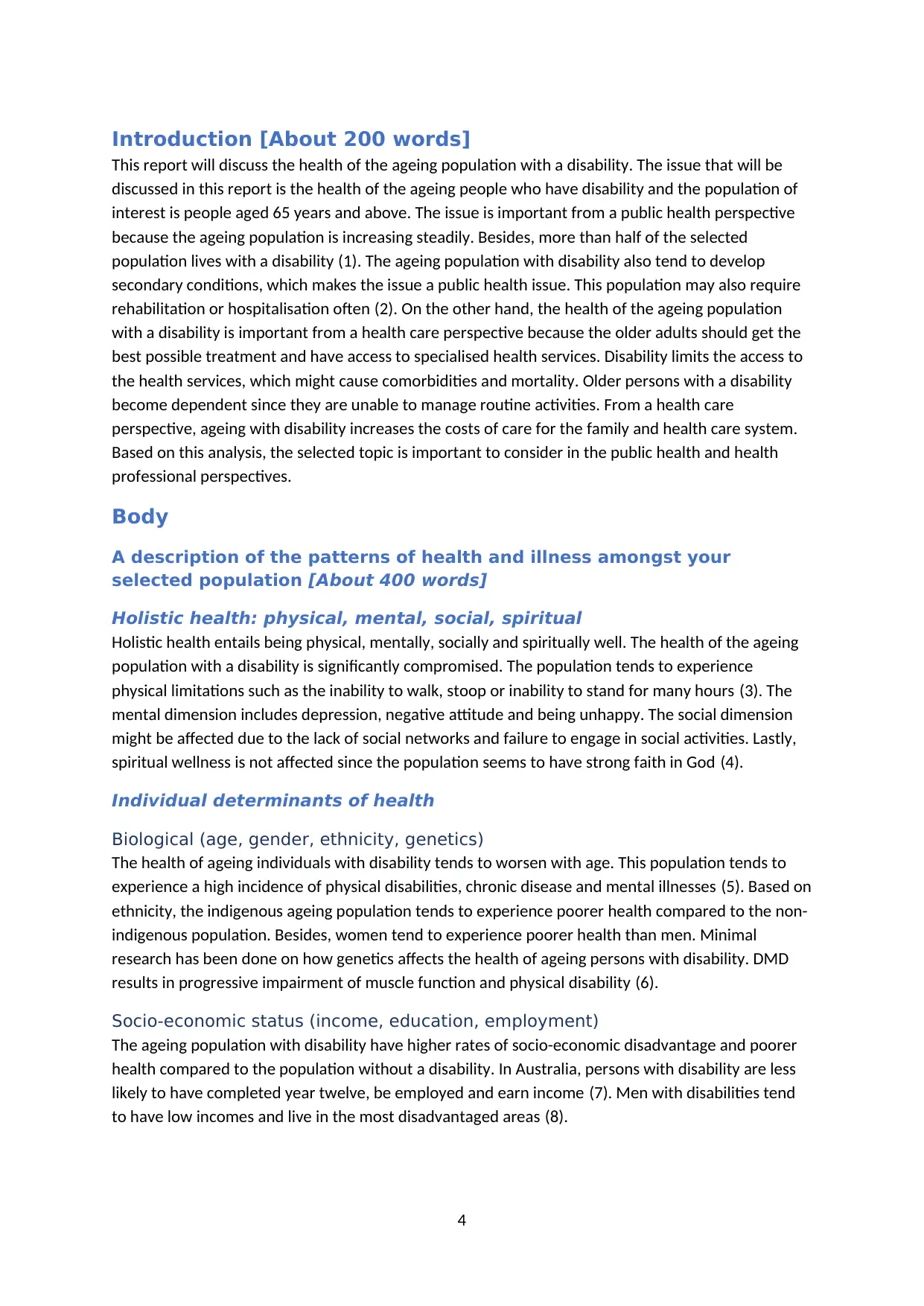
Introduction [About 200 words]
This report will discuss the health of the ageing population with a disability. The issue that will be
discussed in this report is the health of the ageing people who have disability and the population of
interest is people aged 65 years and above. The issue is important from a public health perspective
because the ageing population is increasing steadily. Besides, more than half of the selected
population lives with a disability (1). The ageing population with disability also tend to develop
secondary conditions, which makes the issue a public health issue. This population may also require
rehabilitation or hospitalisation often (2). On the other hand, the health of the ageing population
with a disability is important from a health care perspective because the older adults should get the
best possible treatment and have access to specialised health services. Disability limits the access to
the health services, which might cause comorbidities and mortality. Older persons with a disability
become dependent since they are unable to manage routine activities. From a health care
perspective, ageing with disability increases the costs of care for the family and health care system.
Based on this analysis, the selected topic is important to consider in the public health and health
professional perspectives.
Body
A description of the patterns of health and illness amongst your
selected population [About 400 words]
Holistic health: physical, mental, social, spiritual
Holistic health entails being physical, mentally, socially and spiritually well. The health of the ageing
population with a disability is significantly compromised. The population tends to experience
physical limitations such as the inability to walk, stoop or inability to stand for many hours (3). The
mental dimension includes depression, negative attitude and being unhappy. The social dimension
might be affected due to the lack of social networks and failure to engage in social activities. Lastly,
spiritual wellness is not affected since the population seems to have strong faith in God (4).
Individual determinants of health
Biological (age, gender, ethnicity, genetics)
The health of ageing individuals with disability tends to worsen with age. This population tends to
experience a high incidence of physical disabilities, chronic disease and mental illnesses (5). Based on
ethnicity, the indigenous ageing population tends to experience poorer health compared to the non-
indigenous population. Besides, women tend to experience poorer health than men. Minimal
research has been done on how genetics affects the health of ageing persons with disability. DMD
results in progressive impairment of muscle function and physical disability (6).
Socio-economic status (income, education, employment)
The ageing population with disability have higher rates of socio-economic disadvantage and poorer
health compared to the population without a disability. In Australia, persons with disability are less
likely to have completed year twelve, be employed and earn income (7). Men with disabilities tend
to have low incomes and live in the most disadvantaged areas (8).
4
This report will discuss the health of the ageing population with a disability. The issue that will be
discussed in this report is the health of the ageing people who have disability and the population of
interest is people aged 65 years and above. The issue is important from a public health perspective
because the ageing population is increasing steadily. Besides, more than half of the selected
population lives with a disability (1). The ageing population with disability also tend to develop
secondary conditions, which makes the issue a public health issue. This population may also require
rehabilitation or hospitalisation often (2). On the other hand, the health of the ageing population
with a disability is important from a health care perspective because the older adults should get the
best possible treatment and have access to specialised health services. Disability limits the access to
the health services, which might cause comorbidities and mortality. Older persons with a disability
become dependent since they are unable to manage routine activities. From a health care
perspective, ageing with disability increases the costs of care for the family and health care system.
Based on this analysis, the selected topic is important to consider in the public health and health
professional perspectives.
Body
A description of the patterns of health and illness amongst your
selected population [About 400 words]
Holistic health: physical, mental, social, spiritual
Holistic health entails being physical, mentally, socially and spiritually well. The health of the ageing
population with a disability is significantly compromised. The population tends to experience
physical limitations such as the inability to walk, stoop or inability to stand for many hours (3). The
mental dimension includes depression, negative attitude and being unhappy. The social dimension
might be affected due to the lack of social networks and failure to engage in social activities. Lastly,
spiritual wellness is not affected since the population seems to have strong faith in God (4).
Individual determinants of health
Biological (age, gender, ethnicity, genetics)
The health of ageing individuals with disability tends to worsen with age. This population tends to
experience a high incidence of physical disabilities, chronic disease and mental illnesses (5). Based on
ethnicity, the indigenous ageing population tends to experience poorer health compared to the non-
indigenous population. Besides, women tend to experience poorer health than men. Minimal
research has been done on how genetics affects the health of ageing persons with disability. DMD
results in progressive impairment of muscle function and physical disability (6).
Socio-economic status (income, education, employment)
The ageing population with disability have higher rates of socio-economic disadvantage and poorer
health compared to the population without a disability. In Australia, persons with disability are less
likely to have completed year twelve, be employed and earn income (7). Men with disabilities tend
to have low incomes and live in the most disadvantaged areas (8).
4
Paraphrase This Document
Need a fresh take? Get an instant paraphrase of this document with our AI Paraphraser
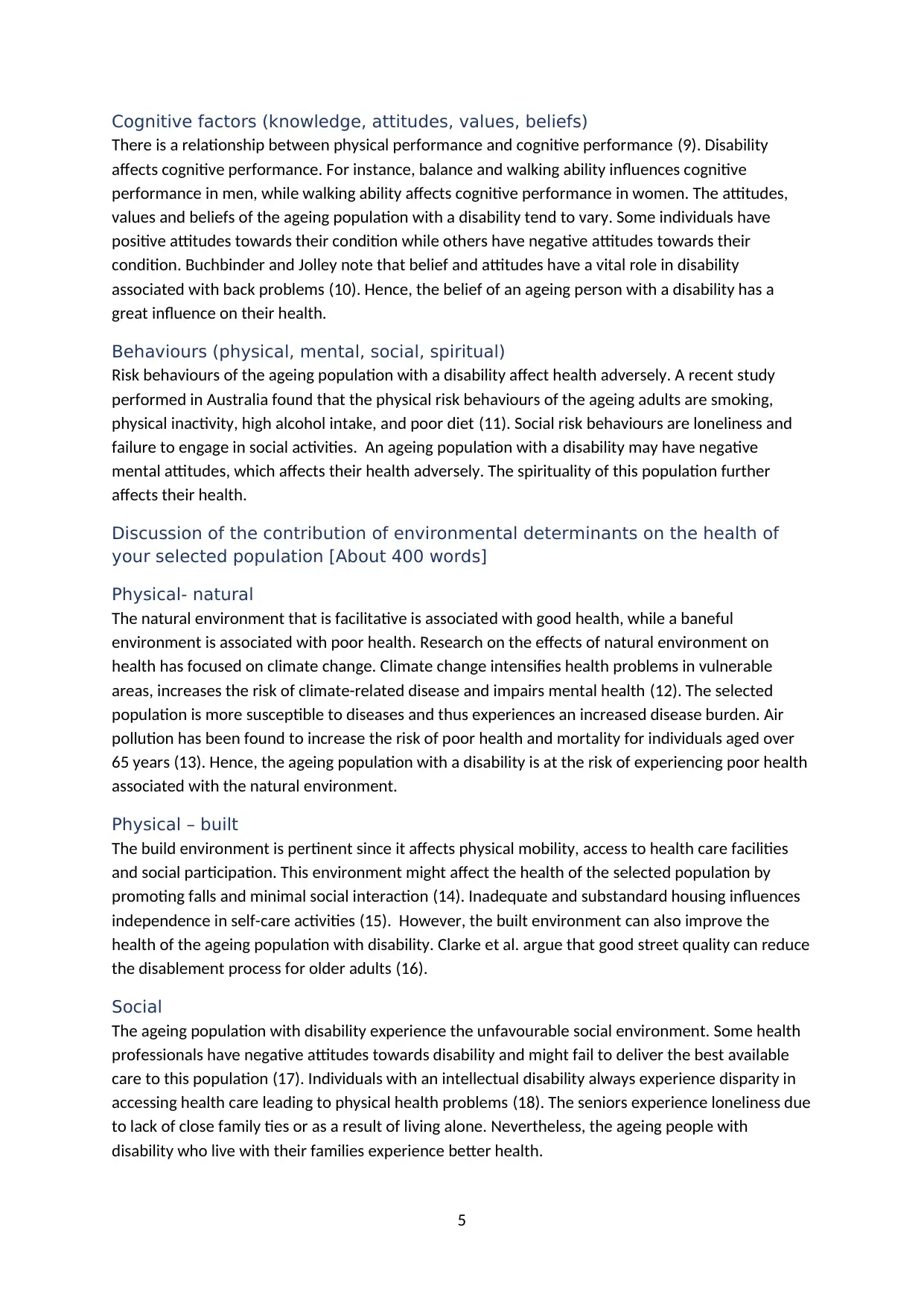
Cognitive factors (knowledge, attitudes, values, beliefs)
There is a relationship between physical performance and cognitive performance (9). Disability
affects cognitive performance. For instance, balance and walking ability influences cognitive
performance in men, while walking ability affects cognitive performance in women. The attitudes,
values and beliefs of the ageing population with a disability tend to vary. Some individuals have
positive attitudes towards their condition while others have negative attitudes towards their
condition. Buchbinder and Jolley note that belief and attitudes have a vital role in disability
associated with back problems (10). Hence, the belief of an ageing person with a disability has a
great influence on their health.
Behaviours (physical, mental, social, spiritual)
Risk behaviours of the ageing population with a disability affect health adversely. A recent study
performed in Australia found that the physical risk behaviours of the ageing adults are smoking,
physical inactivity, high alcohol intake, and poor diet (11). Social risk behaviours are loneliness and
failure to engage in social activities. An ageing population with a disability may have negative
mental attitudes, which affects their health adversely. The spirituality of this population further
affects their health.
Discussion of the contribution of environmental determinants on the health of
your selected population [About 400 words]
Physical- natural
The natural environment that is facilitative is associated with good health, while a baneful
environment is associated with poor health. Research on the effects of natural environment on
health has focused on climate change. Climate change intensifies health problems in vulnerable
areas, increases the risk of climate-related disease and impairs mental health (12). The selected
population is more susceptible to diseases and thus experiences an increased disease burden. Air
pollution has been found to increase the risk of poor health and mortality for individuals aged over
65 years (13). Hence, the ageing population with a disability is at the risk of experiencing poor health
associated with the natural environment.
Physical – built
The build environment is pertinent since it affects physical mobility, access to health care facilities
and social participation. This environment might affect the health of the selected population by
promoting falls and minimal social interaction (14). Inadequate and substandard housing influences
independence in self-care activities (15). However, the built environment can also improve the
health of the ageing population with disability. Clarke et al. argue that good street quality can reduce
the disablement process for older adults (16).
Social
The ageing population with disability experience the unfavourable social environment. Some health
professionals have negative attitudes towards disability and might fail to deliver the best available
care to this population (17). Individuals with an intellectual disability always experience disparity in
accessing health care leading to physical health problems (18). The seniors experience loneliness due
to lack of close family ties or as a result of living alone. Nevertheless, the ageing people with
disability who live with their families experience better health.
5
There is a relationship between physical performance and cognitive performance (9). Disability
affects cognitive performance. For instance, balance and walking ability influences cognitive
performance in men, while walking ability affects cognitive performance in women. The attitudes,
values and beliefs of the ageing population with a disability tend to vary. Some individuals have
positive attitudes towards their condition while others have negative attitudes towards their
condition. Buchbinder and Jolley note that belief and attitudes have a vital role in disability
associated with back problems (10). Hence, the belief of an ageing person with a disability has a
great influence on their health.
Behaviours (physical, mental, social, spiritual)
Risk behaviours of the ageing population with a disability affect health adversely. A recent study
performed in Australia found that the physical risk behaviours of the ageing adults are smoking,
physical inactivity, high alcohol intake, and poor diet (11). Social risk behaviours are loneliness and
failure to engage in social activities. An ageing population with a disability may have negative
mental attitudes, which affects their health adversely. The spirituality of this population further
affects their health.
Discussion of the contribution of environmental determinants on the health of
your selected population [About 400 words]
Physical- natural
The natural environment that is facilitative is associated with good health, while a baneful
environment is associated with poor health. Research on the effects of natural environment on
health has focused on climate change. Climate change intensifies health problems in vulnerable
areas, increases the risk of climate-related disease and impairs mental health (12). The selected
population is more susceptible to diseases and thus experiences an increased disease burden. Air
pollution has been found to increase the risk of poor health and mortality for individuals aged over
65 years (13). Hence, the ageing population with a disability is at the risk of experiencing poor health
associated with the natural environment.
Physical – built
The build environment is pertinent since it affects physical mobility, access to health care facilities
and social participation. This environment might affect the health of the selected population by
promoting falls and minimal social interaction (14). Inadequate and substandard housing influences
independence in self-care activities (15). However, the built environment can also improve the
health of the ageing population with disability. Clarke et al. argue that good street quality can reduce
the disablement process for older adults (16).
Social
The ageing population with disability experience the unfavourable social environment. Some health
professionals have negative attitudes towards disability and might fail to deliver the best available
care to this population (17). Individuals with an intellectual disability always experience disparity in
accessing health care leading to physical health problems (18). The seniors experience loneliness due
to lack of close family ties or as a result of living alone. Nevertheless, the ageing people with
disability who live with their families experience better health.
5
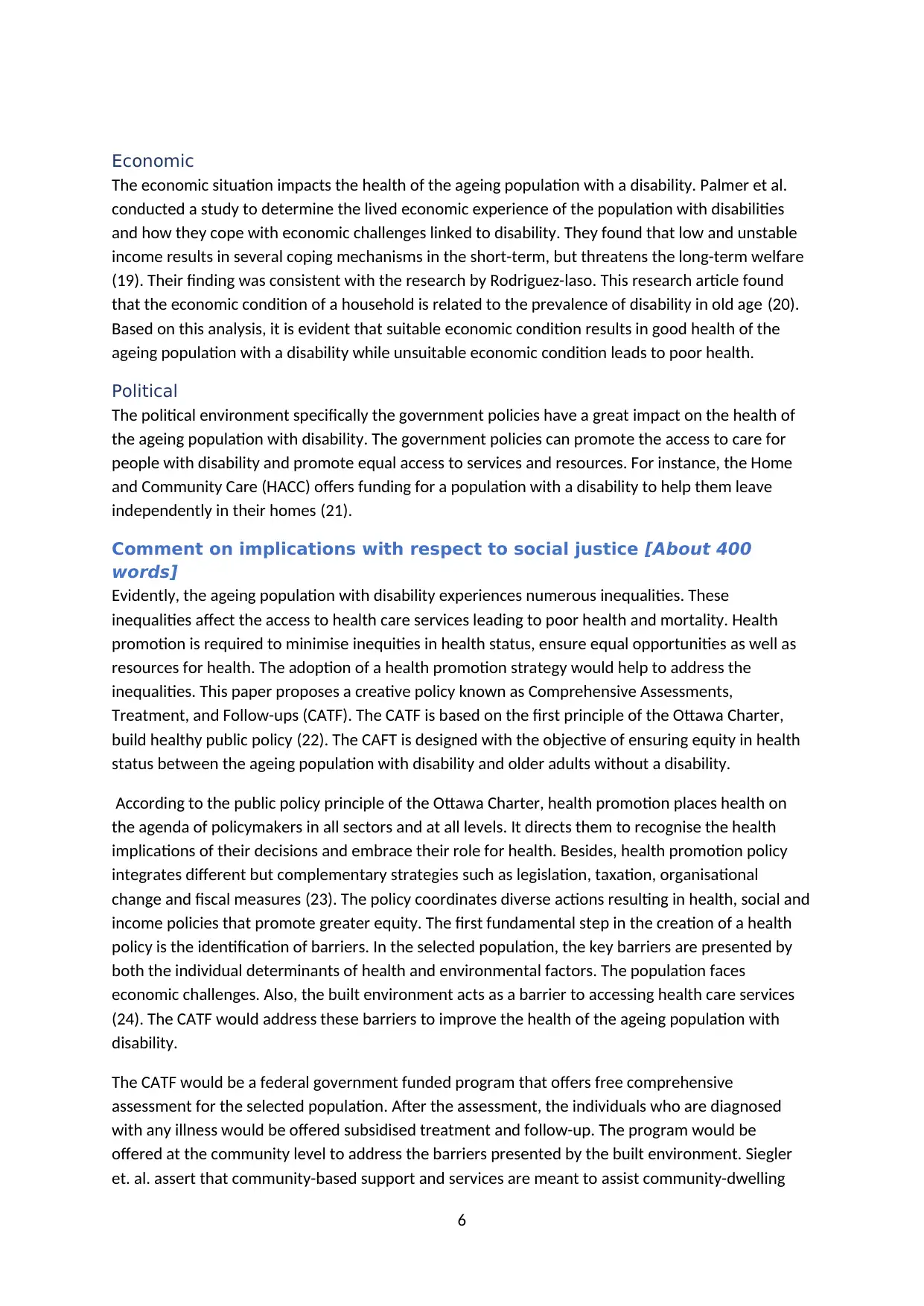
Economic
The economic situation impacts the health of the ageing population with a disability. Palmer et al.
conducted a study to determine the lived economic experience of the population with disabilities
and how they cope with economic challenges linked to disability. They found that low and unstable
income results in several coping mechanisms in the short-term, but threatens the long-term welfare
(19). Their finding was consistent with the research by Rodriguez-laso. This research article found
that the economic condition of a household is related to the prevalence of disability in old age (20).
Based on this analysis, it is evident that suitable economic condition results in good health of the
ageing population with a disability while unsuitable economic condition leads to poor health.
Political
The political environment specifically the government policies have a great impact on the health of
the ageing population with disability. The government policies can promote the access to care for
people with disability and promote equal access to services and resources. For instance, the Home
and Community Care (HACC) offers funding for a population with a disability to help them leave
independently in their homes (21).
Comment on implications with respect to social justice [About 400
words]
Evidently, the ageing population with disability experiences numerous inequalities. These
inequalities affect the access to health care services leading to poor health and mortality. Health
promotion is required to minimise inequities in health status, ensure equal opportunities as well as
resources for health. The adoption of a health promotion strategy would help to address the
inequalities. This paper proposes a creative policy known as Comprehensive Assessments,
Treatment, and Follow-ups (CATF). The CATF is based on the first principle of the Ottawa Charter,
build healthy public policy (22). The CAFT is designed with the objective of ensuring equity in health
status between the ageing population with disability and older adults without a disability.
According to the public policy principle of the Ottawa Charter, health promotion places health on
the agenda of policymakers in all sectors and at all levels. It directs them to recognise the health
implications of their decisions and embrace their role for health. Besides, health promotion policy
integrates different but complementary strategies such as legislation, taxation, organisational
change and fiscal measures (23). The policy coordinates diverse actions resulting in health, social and
income policies that promote greater equity. The first fundamental step in the creation of a health
policy is the identification of barriers. In the selected population, the key barriers are presented by
both the individual determinants of health and environmental factors. The population faces
economic challenges. Also, the built environment acts as a barrier to accessing health care services
(24). The CATF would address these barriers to improve the health of the ageing population with
disability.
The CATF would be a federal government funded program that offers free comprehensive
assessment for the selected population. After the assessment, the individuals who are diagnosed
with any illness would be offered subsidised treatment and follow-up. The program would be
offered at the community level to address the barriers presented by the built environment. Siegler
et. al. assert that community-based support and services are meant to assist community-dwelling
6
The economic situation impacts the health of the ageing population with a disability. Palmer et al.
conducted a study to determine the lived economic experience of the population with disabilities
and how they cope with economic challenges linked to disability. They found that low and unstable
income results in several coping mechanisms in the short-term, but threatens the long-term welfare
(19). Their finding was consistent with the research by Rodriguez-laso. This research article found
that the economic condition of a household is related to the prevalence of disability in old age (20).
Based on this analysis, it is evident that suitable economic condition results in good health of the
ageing population with a disability while unsuitable economic condition leads to poor health.
Political
The political environment specifically the government policies have a great impact on the health of
the ageing population with disability. The government policies can promote the access to care for
people with disability and promote equal access to services and resources. For instance, the Home
and Community Care (HACC) offers funding for a population with a disability to help them leave
independently in their homes (21).
Comment on implications with respect to social justice [About 400
words]
Evidently, the ageing population with disability experiences numerous inequalities. These
inequalities affect the access to health care services leading to poor health and mortality. Health
promotion is required to minimise inequities in health status, ensure equal opportunities as well as
resources for health. The adoption of a health promotion strategy would help to address the
inequalities. This paper proposes a creative policy known as Comprehensive Assessments,
Treatment, and Follow-ups (CATF). The CATF is based on the first principle of the Ottawa Charter,
build healthy public policy (22). The CAFT is designed with the objective of ensuring equity in health
status between the ageing population with disability and older adults without a disability.
According to the public policy principle of the Ottawa Charter, health promotion places health on
the agenda of policymakers in all sectors and at all levels. It directs them to recognise the health
implications of their decisions and embrace their role for health. Besides, health promotion policy
integrates different but complementary strategies such as legislation, taxation, organisational
change and fiscal measures (23). The policy coordinates diverse actions resulting in health, social and
income policies that promote greater equity. The first fundamental step in the creation of a health
policy is the identification of barriers. In the selected population, the key barriers are presented by
both the individual determinants of health and environmental factors. The population faces
economic challenges. Also, the built environment acts as a barrier to accessing health care services
(24). The CATF would address these barriers to improve the health of the ageing population with
disability.
The CATF would be a federal government funded program that offers free comprehensive
assessment for the selected population. After the assessment, the individuals who are diagnosed
with any illness would be offered subsidised treatment and follow-up. The program would be
offered at the community level to address the barriers presented by the built environment. Siegler
et. al. assert that community-based support and services are meant to assist community-dwelling
6
⊘ This is a preview!⊘
Do you want full access?
Subscribe today to unlock all pages.

Trusted by 1+ million students worldwide
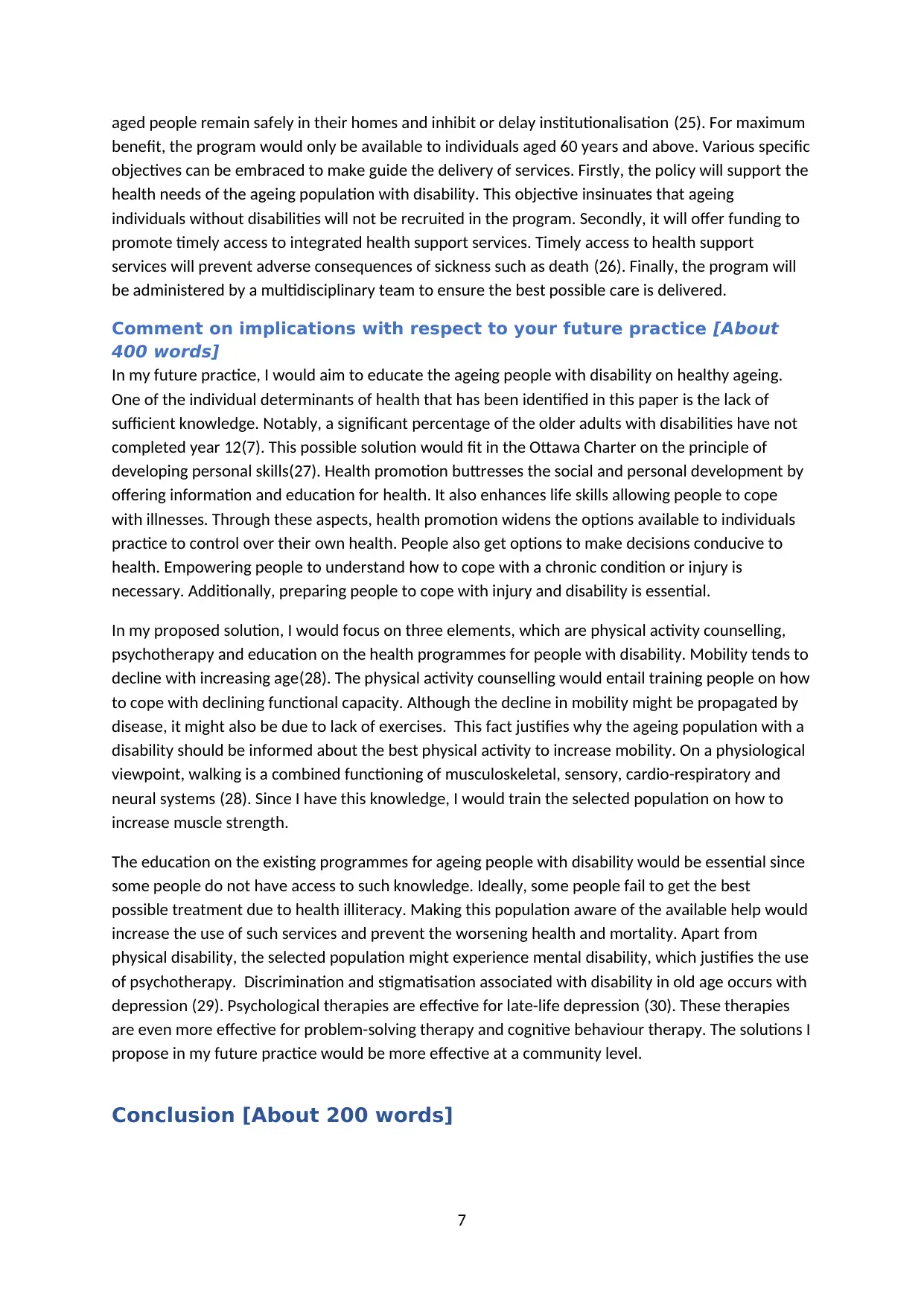
aged people remain safely in their homes and inhibit or delay institutionalisation (25). For maximum
benefit, the program would only be available to individuals aged 60 years and above. Various specific
objectives can be embraced to make guide the delivery of services. Firstly, the policy will support the
health needs of the ageing population with disability. This objective insinuates that ageing
individuals without disabilities will not be recruited in the program. Secondly, it will offer funding to
promote timely access to integrated health support services. Timely access to health support
services will prevent adverse consequences of sickness such as death (26). Finally, the program will
be administered by a multidisciplinary team to ensure the best possible care is delivered.
Comment on implications with respect to your future practice [About
400 words]
In my future practice, I would aim to educate the ageing people with disability on healthy ageing.
One of the individual determinants of health that has been identified in this paper is the lack of
sufficient knowledge. Notably, a significant percentage of the older adults with disabilities have not
completed year 12(7). This possible solution would fit in the Ottawa Charter on the principle of
developing personal skills(27). Health promotion buttresses the social and personal development by
offering information and education for health. It also enhances life skills allowing people to cope
with illnesses. Through these aspects, health promotion widens the options available to individuals
practice to control over their own health. People also get options to make decisions conducive to
health. Empowering people to understand how to cope with a chronic condition or injury is
necessary. Additionally, preparing people to cope with injury and disability is essential.
In my proposed solution, I would focus on three elements, which are physical activity counselling,
psychotherapy and education on the health programmes for people with disability. Mobility tends to
decline with increasing age(28). The physical activity counselling would entail training people on how
to cope with declining functional capacity. Although the decline in mobility might be propagated by
disease, it might also be due to lack of exercises. This fact justifies why the ageing population with a
disability should be informed about the best physical activity to increase mobility. On a physiological
viewpoint, walking is a combined functioning of musculoskeletal, sensory, cardio-respiratory and
neural systems (28). Since I have this knowledge, I would train the selected population on how to
increase muscle strength.
The education on the existing programmes for ageing people with disability would be essential since
some people do not have access to such knowledge. Ideally, some people fail to get the best
possible treatment due to health illiteracy. Making this population aware of the available help would
increase the use of such services and prevent the worsening health and mortality. Apart from
physical disability, the selected population might experience mental disability, which justifies the use
of psychotherapy. Discrimination and stigmatisation associated with disability in old age occurs with
depression (29). Psychological therapies are effective for late-life depression (30). These therapies
are even more effective for problem-solving therapy and cognitive behaviour therapy. The solutions I
propose in my future practice would be more effective at a community level.
Conclusion [About 200 words]
7
benefit, the program would only be available to individuals aged 60 years and above. Various specific
objectives can be embraced to make guide the delivery of services. Firstly, the policy will support the
health needs of the ageing population with disability. This objective insinuates that ageing
individuals without disabilities will not be recruited in the program. Secondly, it will offer funding to
promote timely access to integrated health support services. Timely access to health support
services will prevent adverse consequences of sickness such as death (26). Finally, the program will
be administered by a multidisciplinary team to ensure the best possible care is delivered.
Comment on implications with respect to your future practice [About
400 words]
In my future practice, I would aim to educate the ageing people with disability on healthy ageing.
One of the individual determinants of health that has been identified in this paper is the lack of
sufficient knowledge. Notably, a significant percentage of the older adults with disabilities have not
completed year 12(7). This possible solution would fit in the Ottawa Charter on the principle of
developing personal skills(27). Health promotion buttresses the social and personal development by
offering information and education for health. It also enhances life skills allowing people to cope
with illnesses. Through these aspects, health promotion widens the options available to individuals
practice to control over their own health. People also get options to make decisions conducive to
health. Empowering people to understand how to cope with a chronic condition or injury is
necessary. Additionally, preparing people to cope with injury and disability is essential.
In my proposed solution, I would focus on three elements, which are physical activity counselling,
psychotherapy and education on the health programmes for people with disability. Mobility tends to
decline with increasing age(28). The physical activity counselling would entail training people on how
to cope with declining functional capacity. Although the decline in mobility might be propagated by
disease, it might also be due to lack of exercises. This fact justifies why the ageing population with a
disability should be informed about the best physical activity to increase mobility. On a physiological
viewpoint, walking is a combined functioning of musculoskeletal, sensory, cardio-respiratory and
neural systems (28). Since I have this knowledge, I would train the selected population on how to
increase muscle strength.
The education on the existing programmes for ageing people with disability would be essential since
some people do not have access to such knowledge. Ideally, some people fail to get the best
possible treatment due to health illiteracy. Making this population aware of the available help would
increase the use of such services and prevent the worsening health and mortality. Apart from
physical disability, the selected population might experience mental disability, which justifies the use
of psychotherapy. Discrimination and stigmatisation associated with disability in old age occurs with
depression (29). Psychological therapies are effective for late-life depression (30). These therapies
are even more effective for problem-solving therapy and cognitive behaviour therapy. The solutions I
propose in my future practice would be more effective at a community level.
Conclusion [About 200 words]
7
Paraphrase This Document
Need a fresh take? Get an instant paraphrase of this document with our AI Paraphraser
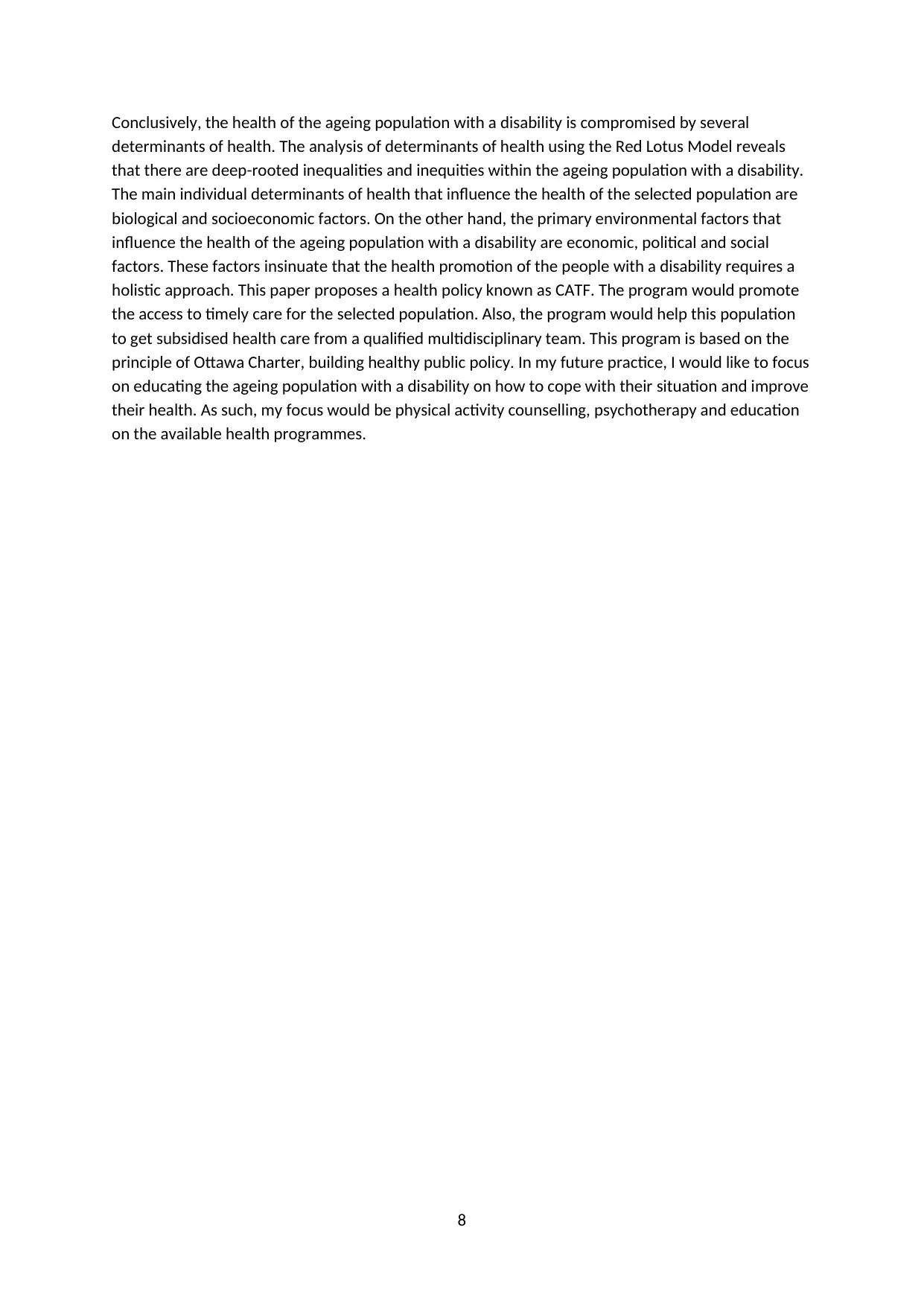
Conclusively, the health of the ageing population with a disability is compromised by several
determinants of health. The analysis of determinants of health using the Red Lotus Model reveals
that there are deep-rooted inequalities and inequities within the ageing population with a disability.
The main individual determinants of health that influence the health of the selected population are
biological and socioeconomic factors. On the other hand, the primary environmental factors that
influence the health of the ageing population with a disability are economic, political and social
factors. These factors insinuate that the health promotion of the people with a disability requires a
holistic approach. This paper proposes a health policy known as CATF. The program would promote
the access to timely care for the selected population. Also, the program would help this population
to get subsidised health care from a qualified multidisciplinary team. This program is based on the
principle of Ottawa Charter, building healthy public policy. In my future practice, I would like to focus
on educating the ageing population with a disability on how to cope with their situation and improve
their health. As such, my focus would be physical activity counselling, psychotherapy and education
on the available health programmes.
8
determinants of health. The analysis of determinants of health using the Red Lotus Model reveals
that there are deep-rooted inequalities and inequities within the ageing population with a disability.
The main individual determinants of health that influence the health of the selected population are
biological and socioeconomic factors. On the other hand, the primary environmental factors that
influence the health of the ageing population with a disability are economic, political and social
factors. These factors insinuate that the health promotion of the people with a disability requires a
holistic approach. This paper proposes a health policy known as CATF. The program would promote
the access to timely care for the selected population. Also, the program would help this population
to get subsidised health care from a qualified multidisciplinary team. This program is based on the
principle of Ottawa Charter, building healthy public policy. In my future practice, I would like to focus
on educating the ageing population with a disability on how to cope with their situation and improve
their health. As such, my focus would be physical activity counselling, psychotherapy and education
on the available health programmes.
8
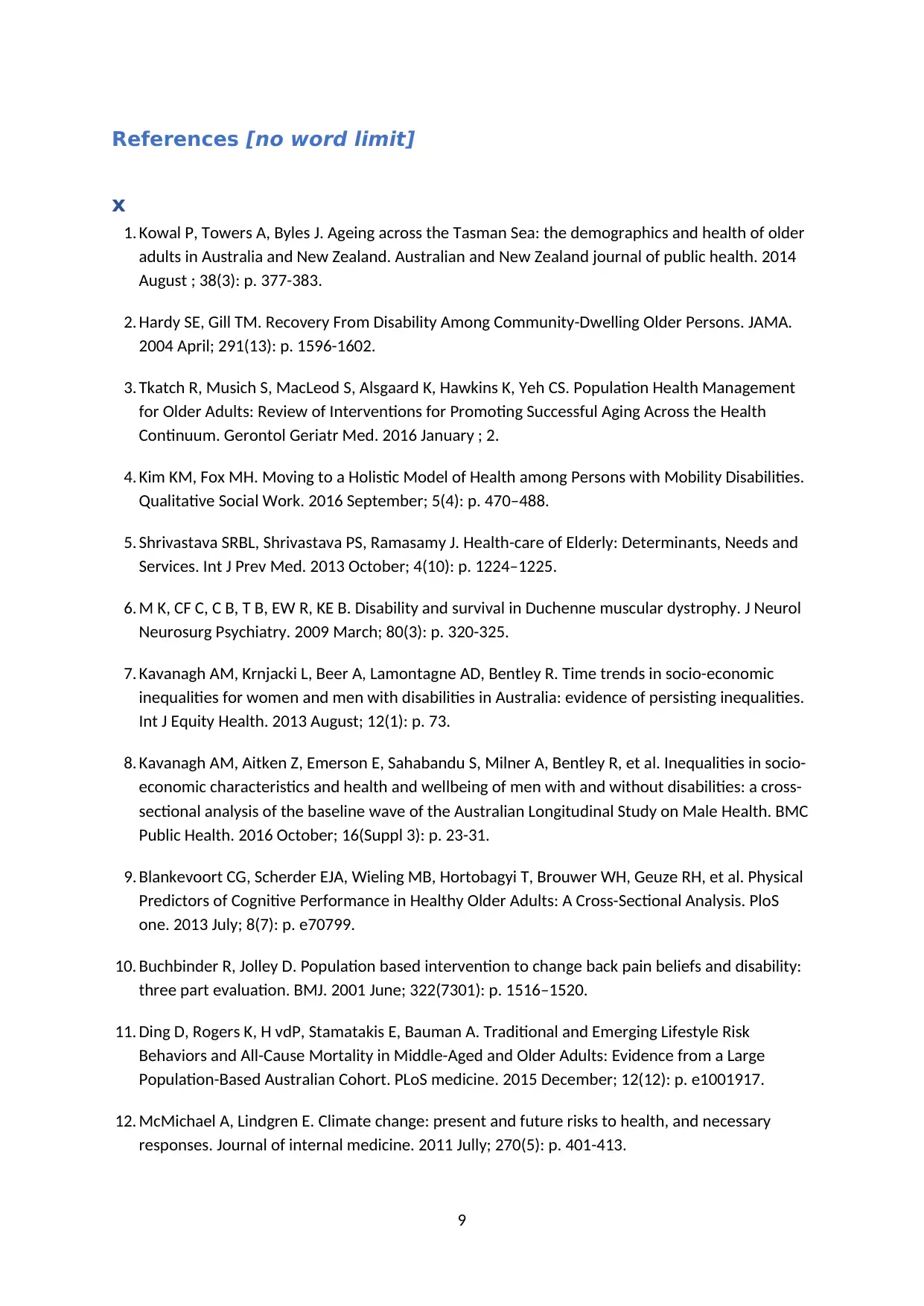
References [no word limit]
x
1. Kowal P, Towers A, Byles J. Ageing across the Tasman Sea: the demographics and health of older
adults in Australia and New Zealand. Australian and New Zealand journal of public health. 2014
August ; 38(3): p. 377-383.
2. Hardy SE, Gill TM. Recovery From Disability Among Community-Dwelling Older Persons. JAMA.
2004 April; 291(13): p. 1596-1602.
3. Tkatch R, Musich S, MacLeod S, Alsgaard K, Hawkins K, Yeh CS. Population Health Management
for Older Adults: Review of Interventions for Promoting Successful Aging Across the Health
Continuum. Gerontol Geriatr Med. 2016 January ; 2.
4. Kim KM, Fox MH. Moving to a Holistic Model of Health among Persons with Mobility Disabilities.
Qualitative Social Work. 2016 September; 5(4): p. 470–488.
5. Shrivastava SRBL, Shrivastava PS, Ramasamy J. Health-care of Elderly: Determinants, Needs and
Services. Int J Prev Med. 2013 October; 4(10): p. 1224–1225.
6. M K, CF C, C B, T B, EW R, KE B. Disability and survival in Duchenne muscular dystrophy. J Neurol
Neurosurg Psychiatry. 2009 March; 80(3): p. 320-325.
7. Kavanagh AM, Krnjacki L, Beer A, Lamontagne AD, Bentley R. Time trends in socio-economic
inequalities for women and men with disabilities in Australia: evidence of persisting inequalities.
Int J Equity Health. 2013 August; 12(1): p. 73.
8. Kavanagh AM, Aitken Z, Emerson E, Sahabandu S, Milner A, Bentley R, et al. Inequalities in socio-
economic characteristics and health and wellbeing of men with and without disabilities: a cross-
sectional analysis of the baseline wave of the Australian Longitudinal Study on Male Health. BMC
Public Health. 2016 October; 16(Suppl 3): p. 23-31.
9. Blankevoort CG, Scherder EJA, Wieling MB, Hortobagyi T, Brouwer WH, Geuze RH, et al. Physical
Predictors of Cognitive Performance in Healthy Older Adults: A Cross-Sectional Analysis. PloS
one. 2013 July; 8(7): p. e70799.
10. Buchbinder R, Jolley D. Population based intervention to change back pain beliefs and disability:
three part evaluation. BMJ. 2001 June; 322(7301): p. 1516–1520.
11. Ding D, Rogers K, H vdP, Stamatakis E, Bauman A. Traditional and Emerging Lifestyle Risk
Behaviors and All-Cause Mortality in Middle-Aged and Older Adults: Evidence from a Large
Population-Based Australian Cohort. PLoS medicine. 2015 December; 12(12): p. e1001917.
12. McMichael A, Lindgren E. Climate change: present and future risks to health, and necessary
responses. Journal of internal medicine. 2011 Jully; 270(5): p. 401-413.
9
x
1. Kowal P, Towers A, Byles J. Ageing across the Tasman Sea: the demographics and health of older
adults in Australia and New Zealand. Australian and New Zealand journal of public health. 2014
August ; 38(3): p. 377-383.
2. Hardy SE, Gill TM. Recovery From Disability Among Community-Dwelling Older Persons. JAMA.
2004 April; 291(13): p. 1596-1602.
3. Tkatch R, Musich S, MacLeod S, Alsgaard K, Hawkins K, Yeh CS. Population Health Management
for Older Adults: Review of Interventions for Promoting Successful Aging Across the Health
Continuum. Gerontol Geriatr Med. 2016 January ; 2.
4. Kim KM, Fox MH. Moving to a Holistic Model of Health among Persons with Mobility Disabilities.
Qualitative Social Work. 2016 September; 5(4): p. 470–488.
5. Shrivastava SRBL, Shrivastava PS, Ramasamy J. Health-care of Elderly: Determinants, Needs and
Services. Int J Prev Med. 2013 October; 4(10): p. 1224–1225.
6. M K, CF C, C B, T B, EW R, KE B. Disability and survival in Duchenne muscular dystrophy. J Neurol
Neurosurg Psychiatry. 2009 March; 80(3): p. 320-325.
7. Kavanagh AM, Krnjacki L, Beer A, Lamontagne AD, Bentley R. Time trends in socio-economic
inequalities for women and men with disabilities in Australia: evidence of persisting inequalities.
Int J Equity Health. 2013 August; 12(1): p. 73.
8. Kavanagh AM, Aitken Z, Emerson E, Sahabandu S, Milner A, Bentley R, et al. Inequalities in socio-
economic characteristics and health and wellbeing of men with and without disabilities: a cross-
sectional analysis of the baseline wave of the Australian Longitudinal Study on Male Health. BMC
Public Health. 2016 October; 16(Suppl 3): p. 23-31.
9. Blankevoort CG, Scherder EJA, Wieling MB, Hortobagyi T, Brouwer WH, Geuze RH, et al. Physical
Predictors of Cognitive Performance in Healthy Older Adults: A Cross-Sectional Analysis. PloS
one. 2013 July; 8(7): p. e70799.
10. Buchbinder R, Jolley D. Population based intervention to change back pain beliefs and disability:
three part evaluation. BMJ. 2001 June; 322(7301): p. 1516–1520.
11. Ding D, Rogers K, H vdP, Stamatakis E, Bauman A. Traditional and Emerging Lifestyle Risk
Behaviors and All-Cause Mortality in Middle-Aged and Older Adults: Evidence from a Large
Population-Based Australian Cohort. PLoS medicine. 2015 December; 12(12): p. e1001917.
12. McMichael A, Lindgren E. Climate change: present and future risks to health, and necessary
responses. Journal of internal medicine. 2011 Jully; 270(5): p. 401-413.
9
⊘ This is a preview!⊘
Do you want full access?
Subscribe today to unlock all pages.

Trusted by 1+ million students worldwide
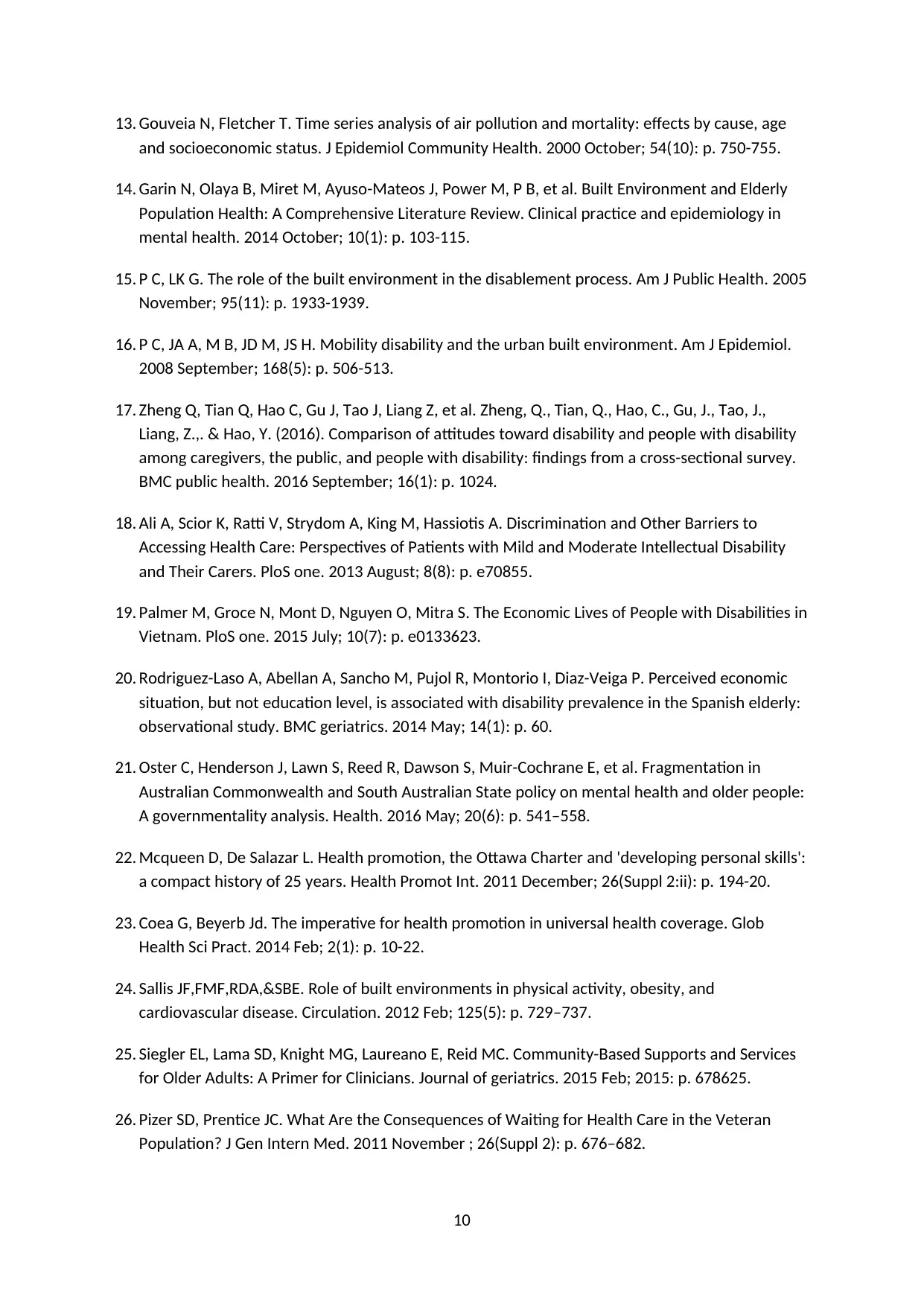
13. Gouveia N, Fletcher T. Time series analysis of air pollution and mortality: effects by cause, age
and socioeconomic status. J Epidemiol Community Health. 2000 October; 54(10): p. 750-755.
14. Garin N, Olaya B, Miret M, Ayuso-Mateos J, Power M, P B, et al. Built Environment and Elderly
Population Health: A Comprehensive Literature Review. Clinical practice and epidemiology in
mental health. 2014 October; 10(1): p. 103-115.
15. P C, LK G. The role of the built environment in the disablement process. Am J Public Health. 2005
November; 95(11): p. 1933-1939.
16. P C, JA A, M B, JD M, JS H. Mobility disability and the urban built environment. Am J Epidemiol.
2008 September; 168(5): p. 506-513.
17. Zheng Q, Tian Q, Hao C, Gu J, Tao J, Liang Z, et al. Zheng, Q., Tian, Q., Hao, C., Gu, J., Tao, J.,
Liang, Z.,. & Hao, Y. (2016). Comparison of attitudes toward disability and people with disability
among caregivers, the public, and people with disability: findings from a cross-sectional survey.
BMC public health. 2016 September; 16(1): p. 1024.
18. Ali A, Scior K, Ratti V, Strydom A, King M, Hassiotis A. Discrimination and Other Barriers to
Accessing Health Care: Perspectives of Patients with Mild and Moderate Intellectual Disability
and Their Carers. PloS one. 2013 August; 8(8): p. e70855.
19. Palmer M, Groce N, Mont D, Nguyen O, Mitra S. The Economic Lives of People with Disabilities in
Vietnam. PloS one. 2015 July; 10(7): p. e0133623.
20. Rodriguez-Laso A, Abellan A, Sancho M, Pujol R, Montorio I, Diaz-Veiga P. Perceived economic
situation, but not education level, is associated with disability prevalence in the Spanish elderly:
observational study. BMC geriatrics. 2014 May; 14(1): p. 60.
21. Oster C, Henderson J, Lawn S, Reed R, Dawson S, Muir-Cochrane E, et al. Fragmentation in
Australian Commonwealth and South Australian State policy on mental health and older people:
A governmentality analysis. Health. 2016 May; 20(6): p. 541–558.
22. Mcqueen D, De Salazar L. Health promotion, the Ottawa Charter and 'developing personal skills':
a compact history of 25 years. Health Promot Int. 2011 December; 26(Suppl 2:ii): p. 194-20.
23. Coea G, Beyerb Jd. The imperative for health promotion in universal health coverage. Glob
Health Sci Pract. 2014 Feb; 2(1): p. 10-22.
24. Sallis JF,FMF,RDA,&SBE. Role of built environments in physical activity, obesity, and
cardiovascular disease. Circulation. 2012 Feb; 125(5): p. 729–737.
25. Siegler EL, Lama SD, Knight MG, Laureano E, Reid MC. Community-Based Supports and Services
for Older Adults: A Primer for Clinicians. Journal of geriatrics. 2015 Feb; 2015: p. 678625.
26. Pizer SD, Prentice JC. What Are the Consequences of Waiting for Health Care in the Veteran
Population? J Gen Intern Med. 2011 November ; 26(Suppl 2): p. 676–682.
10
and socioeconomic status. J Epidemiol Community Health. 2000 October; 54(10): p. 750-755.
14. Garin N, Olaya B, Miret M, Ayuso-Mateos J, Power M, P B, et al. Built Environment and Elderly
Population Health: A Comprehensive Literature Review. Clinical practice and epidemiology in
mental health. 2014 October; 10(1): p. 103-115.
15. P C, LK G. The role of the built environment in the disablement process. Am J Public Health. 2005
November; 95(11): p. 1933-1939.
16. P C, JA A, M B, JD M, JS H. Mobility disability and the urban built environment. Am J Epidemiol.
2008 September; 168(5): p. 506-513.
17. Zheng Q, Tian Q, Hao C, Gu J, Tao J, Liang Z, et al. Zheng, Q., Tian, Q., Hao, C., Gu, J., Tao, J.,
Liang, Z.,. & Hao, Y. (2016). Comparison of attitudes toward disability and people with disability
among caregivers, the public, and people with disability: findings from a cross-sectional survey.
BMC public health. 2016 September; 16(1): p. 1024.
18. Ali A, Scior K, Ratti V, Strydom A, King M, Hassiotis A. Discrimination and Other Barriers to
Accessing Health Care: Perspectives of Patients with Mild and Moderate Intellectual Disability
and Their Carers. PloS one. 2013 August; 8(8): p. e70855.
19. Palmer M, Groce N, Mont D, Nguyen O, Mitra S. The Economic Lives of People with Disabilities in
Vietnam. PloS one. 2015 July; 10(7): p. e0133623.
20. Rodriguez-Laso A, Abellan A, Sancho M, Pujol R, Montorio I, Diaz-Veiga P. Perceived economic
situation, but not education level, is associated with disability prevalence in the Spanish elderly:
observational study. BMC geriatrics. 2014 May; 14(1): p. 60.
21. Oster C, Henderson J, Lawn S, Reed R, Dawson S, Muir-Cochrane E, et al. Fragmentation in
Australian Commonwealth and South Australian State policy on mental health and older people:
A governmentality analysis. Health. 2016 May; 20(6): p. 541–558.
22. Mcqueen D, De Salazar L. Health promotion, the Ottawa Charter and 'developing personal skills':
a compact history of 25 years. Health Promot Int. 2011 December; 26(Suppl 2:ii): p. 194-20.
23. Coea G, Beyerb Jd. The imperative for health promotion in universal health coverage. Glob
Health Sci Pract. 2014 Feb; 2(1): p. 10-22.
24. Sallis JF,FMF,RDA,&SBE. Role of built environments in physical activity, obesity, and
cardiovascular disease. Circulation. 2012 Feb; 125(5): p. 729–737.
25. Siegler EL, Lama SD, Knight MG, Laureano E, Reid MC. Community-Based Supports and Services
for Older Adults: A Primer for Clinicians. Journal of geriatrics. 2015 Feb; 2015: p. 678625.
26. Pizer SD, Prentice JC. What Are the Consequences of Waiting for Health Care in the Veteran
Population? J Gen Intern Med. 2011 November ; 26(Suppl 2): p. 676–682.
10
1 out of 10
Related Documents
Your All-in-One AI-Powered Toolkit for Academic Success.
+13062052269
info@desklib.com
Available 24*7 on WhatsApp / Email
![[object Object]](/_next/static/media/star-bottom.7253800d.svg)
Unlock your academic potential
Copyright © 2020–2025 A2Z Services. All Rights Reserved. Developed and managed by ZUCOL.





